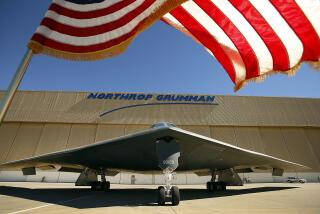Northrop Chief Expects 2-Year Sales Decline
- Share via
Northrop Chairman Thomas V. Jones told securities analysts Thursday that the aerospace corporation expects to post sales declines in 1988 and 1989, a surprising disclosure that prompted some analysts to reduce their estimates of Northrop earnings.
Jones did not indicate how much sales would decline, but he told analysts at Drexel Burnham Lambert in New York that revenue in 1988 and 1989 would be “somewhat less than the $6 billion recorded in 1987.” The downturn would be followed by “long-term sales growth,” he added.
He gave no specific reason, although some analysts believe that the slowdown could be linked to a probable slip of the highly classified B-2 Stealth bomber schedule. Northrop is expected to roll out the first bomber in mid-November.
Lawrence M. Harris, an analyst at Bateman Eichler, Hill Richards, said the Air Force may be delaying the B-2 production schedule so that flight testing of the first aircraft can be undertaken before a large number of aircraft are produced.
Congress has harshly criticized the Air Force for the B-1 bomber program because of major flaws in that aircraft’s electronic warfare system, built by Eaton Corp., that did not become known until most of the fleet had been produced. So-called concurrency in developing, testing and producing aircraft has become a controversy in Congress.
Harris said that based on a sales decline, he would cut his estimate for Northrop’s 1989 earnings from $5 to $4 a share and the 1988 earnings from $5 to $4.50 a share.
Joseph E. Campbell, Paine Webber analyst, said his estimates had anticipated flat 1988 and 1989 sales because of Northrop’s divestiture of its aircraft service business.
Expected Increase
Nonetheless, he said there could be other surprises looming. He estimated that B-2 bomber revenue has declined in the past three quarters and he suspects that the concurrency issue could be causing the Air Force to delay the program.
Paul Nisbet, aerospace analyst at Prudential-Bache Securities, said a sales decline in 1989 would not come as a surprise; he had expected a 10% revenue increase next year.
“It is hard to tell what the cause is, whether it is delays on their part or overestimates on our part,” he said. Nisbet said he may reduce his earnings estimate, but noted that Northrop’s profit margins may increase next year and override the effect of the decline.
John Simon, analyst at Seidler Amdec Securities, said he had been alerted to the expected decline in sales several months ago and trimmed his estimates at that time.
Simon forecasts sales of only $5.4 billion this year and next year, a decline that seems much larger that implied in Jones’ statement. He projects earnings of only $1.60 a share in 1989.
Jones’ remarks were summarized in a news release from the corporation. Drexel analysts could not be reached to comment on whether Jones had an explanation for the forecast.
In other remarks, Jones said research and development programs represent about 60% of the company’s business and production programs, 40%. In three or four years, the mix will be 80% production and 20% research, he said.
He said the company has reached preliminary agreement to convert about $500 million of short-term debt to medium-term financing through a private placement.
The troubled MX missile guidance program is continuing to recover, he said. The Air Force is withholding $20 million of contract payments to the firm because of late deliveries, down from a peak of $145 million last December.
More to Read
Inside the business of entertainment
The Wide Shot brings you news, analysis and insights on everything from streaming wars to production — and what it all means for the future.
You may occasionally receive promotional content from the Los Angeles Times.











